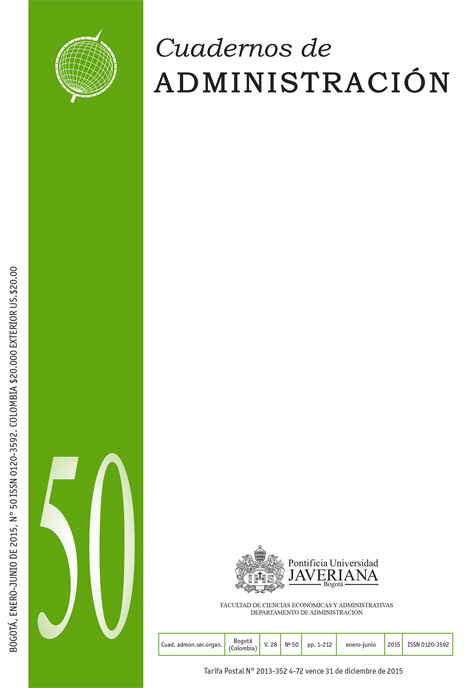Efecto de la actitud de los directivos frente al riesgo en la orientación exportadora de las empresas. Un estudio empírico en Colombia
##plugins.themes.bootstrap3.article.details##
El artículo presenta una investigación desarrollada con 308 empresas
colombianas exportadoras con el fin de indagar cómo influye la actitud
de los directivos frente al riesgo (AFR) en la orientación exportadora (OE)
de las empresas. Para esto se abordaron organizaciones exportadoras
tradicionales y empresas Born Global utilizando como método estadístico
las regresiones lineales múltiples. Los resultados muestran que dichas
empresas tiene un nivel medio tanto de AFR como de OE, y que la primera
variable afecta positiva y muy significativamente la segunda. Se concluye
que cuando los directivos asumen más riesgos, las organizaciones tienen
mayor orientación hacia mercados externos. Futuras investigaciones
podrían revisar esta relación en los llamados sectores de clase mundial
de Colombia y en otros países en vía de desarrollo.
empresas exportadoras tradicionais, Born Global, cultura organizacional, negócios internacionais.empresas exportadoras tradicionales, Born Global, cultura organizacional, negocios internacionalestraditional export companies, Born Global, organizational culture, international business
Avlonitis, G. J., and Gounaris, S. P. (1999). Marketing orientation and its determinants: An empirical analysis. European Journal of Marketing, 33 (11/12), 1003-1037.
Basave, J. (2000). Empresas mexicanas ante la globalización. México D.F.: Editorial Miguel Ángel Porrúa.
Cadogan, J. W., and Diamantopoulos, A. (1995). Narver and Slater, Kohli and Jaworski and the market orientation construct: Integration and internationalization. Journal of Strategic Marketing, 3 (1), 41-60.
Cadogan, J. W., Diamantopoulos, A., and De Mortanges, C. P. (1999). A measure of export market orientation: Scale development and cross-cultural validation. Journal of International Business Studies, 30, 689-707.
Cadogan, J. W., Diamantopoulos, A., and Siguaw, J. A. (2002). Export market-oriented activities: Their antecedents and performance consequences. Journal of International Business Studies, 33 (3), 615-626.
Day, G. (1994). Continuous learning about markets. California Management Review, 36 (4), 9-31.
Deng, S., and Dart, J. (1994). Measuring market orientation: A multifactor, multi-ítem approach. Journal of Marketing Management, 10, 725-742.
Deshpandé, R., Farley, J., and Webster, J. (1993). Corporate culture, customer orientation, and innovativeness in Japanese firms: A quadrat analysis. Journal of Marketing, 57 (1), 23-37.
Diamantopolus. A., and Cadogan, J. W. (1996). Internationalizing the market orientation construct: An in-depth interview approach. Journal of Strategic Marketing, 4 (1), 23-52.
Diamantopoulos, A., and Hart, S. (1993). Linking market orientation and company performance: Preliminary evidence on Kohli and Jaworski framework. Journal of Strategic Marketing, 1, 93-121.
García, F. y Avella, L. (2007). Intensidad exportadora y percepción de barreras a la exportación: un estudio de casos. Investigaciones Europeas de Dirección y Economía de la Empresa, 13 (3), 93-106.
Greenley, G. (1995). Forms of market orientation in UK Companies. Journal of Management Studies, 32 (1), 47-66.
Hair, J., Anderson, R., Tatham, R. y Black, W. (1999). Análisis Multivariante, 5ª ed., Madrid: Prentice Hall.
Halek, M., and Eisenhauer, J. G. (2001). Demography of risk aversion. Journal of Risk and Insurance, 68 (1), 1-24.
Harveston, P., Ben L., and Davis, P. (2000). Internationalization of Born Global and gradual globalizing firms: The impact of the manager. Advances in Competitiveness Research, 8 (1), 92-99.
Jaworski, B. J., and Kohli, A. K. (1993). Market orientation: antecedents and consequences. The Journal of Marketing, 57, 53-70.
Jaworski, B. J., and Kohli, A. K. (1996). Market orientation: Review, refinement and roadmap. Journal of Market-Focused Marketing, 1 (2), 119-135.
Johanson, J., and Vahlne, J. E. (1977). The internationalization process of the firm-a model of knowledge development and increasing foreign market commitments. Journal of International Business Studies, 8, 23-32.
Kaynak, E., and Kothari, V. (1984). Export behaviour of small and medium-sized manufacturers: Some policy guidelines for international marketers. Management International Review, 24 (2), 61-69.
Knight, G. A., and Cavusgil, S. T. (2004). Innovation, organizational capabilities, and the born-global firm. Journal of International Business Studies, 35 (2), 124-141.
Madsen, T. K., and Servais, P. (1997). The internationalization of Born Globals: An evolutionary process? International Business Review, 6 (6), 561-583.
Madsen, T. K., Rasmussen, E., and Servais, P. (2001). Differences and similarities between born globals and other types of exporters (vol. 10, pp. 247-265). Emerald Group Publishing Limited.
March, J. G. (1996). Learning to be risk averse. Psychological Review, 103 (2), 309-319.
Martín, J. (2003). Orientación al mercado y proceso de internacionalización de las empresas. Tesis doctoral. Departamento de Economía y Administración de Empresas, Universidad de Málaga. Recuperado el 23 de octubre del 2014 de: http://riuma.uma.es/xmlui/bitstream/handle/10630/2568/1669952x.pdf?sequence=1
McKinsey & Co. (1993). Emerging exporters : Australia's high value-added manufacturing exporters: final report of the study by McKinsey & Company and the Australian Manufacturing Council Secretariat to the Australian Manufacturing Council, June.
Narver, J., and Slater, S. (1990). The effect of a market orientation on business profitability. Journal of Marketing, 54, 20-35.
Oviatt, B. M., and McDougall, P. P. (1994). Toward a theory of international new ventures. Journal of International Business Studies, 25 (1), 45-64.
Pla, J., y León, F. (2004). La dirección de empresas internacionales. Madrid: Pearson Prentice Hall.
Shapiro, P. (1988). What the hell is ‘Market Oriented’? Harvard Business Review, 66 (November-December), 119-125.
Sharma, D. D., and Blomstermo, A. (2003). The internationalization process of Born Globals: A network review. International Business Review, 12 (6), 739-753.
Shoham, A. (1999). Bounded rationality, planning, standarization of international strategy and export performance. An structural model examination. Journal of International Marketing, 7 (2) 24-50.
Steenkamp, E. M., and Burgess, S. M. (2006). Marketing renaissance: How research in emerging markets advances marketing science and practice. International Journal of Research in Marketing, 23, 337-356.
Webster, F. (1988). The rediscovery of the marketing concept. Business Horizons, 31 (3), 29-39.
Xiong, H., Xie, J., and Deng, X. (2011). Risk-averse decision making in overbooking problem. Journal of the Operational Research Society, 62 (9), 1655-1665.
Zapata, E. (2005). Las Pymes y su problemática empresarial. Análisis de casos. En G. Calderón y G. Castaño. Investigación en administración en América Latina: Evolución y resultados. Universidad Nacional de Colombia. Manizales, Colombia.


